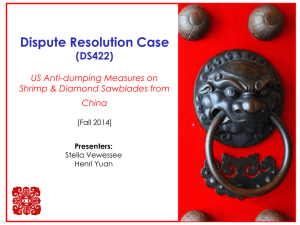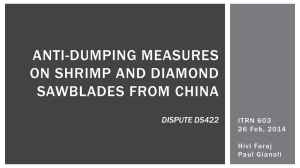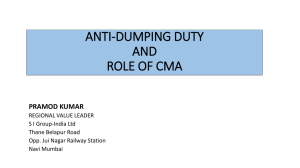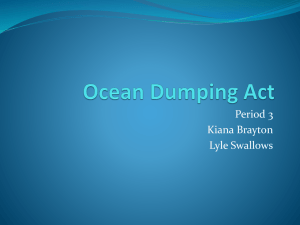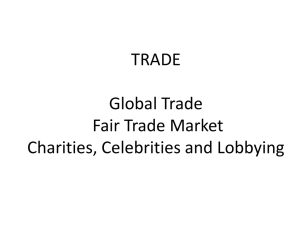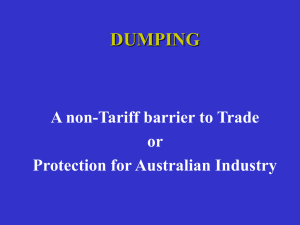team presentation. - International Trade Relations
advertisement
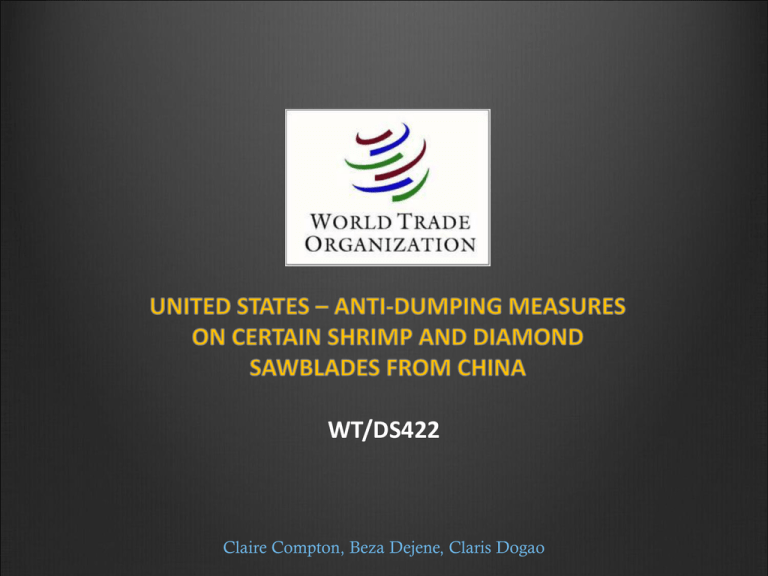
WT/DS422 Claire Compton, Beza Dejene, Claris Dogao Trade: Exports U.S. – China Trade • 1980-2004, U.S.-China trade rises from $5 billion to $231 billion. • 2000 – President Clinton signs law granting permanent normal trade relations to China, and opening path to WTO membership. • 2003 – China became the largest single source of the U.S. global deficit. • 2005 – U.S. bilateral trade deficit with China exceeds $200 billion, over 25% of total U.S. imbalance. • 2005 – U.S. current account deficit reaches annual rate of $900 billion. After an average of 1.6 percent of its GDP from 1993-2002, China’s global current account surplus rose to nearly $150 billion 2005, or nearly 7 percent of its GDP. • 2006-China surpasses Mexico as the United States’ second-biggest trading partner, after Canada. Economic & Political Context • “China-bashing has captured the headlines …. Susan Collins and Evan Bayh, are touting the Stopping Overseas Subsidies Act, which would allow American firms to get countervailing duties to make up for Chinese subsidies, including a subsidized exchange rate. China is not currently subject to America's antisubsidy law as it is deemed a “non-market economy” (which makes it easier for American firms to file antidumping cases against it). But declaring China a market economy for the purposes of subsidies, and a nonmarket economy for the purposes of anti-dumping, is against WTO rules.” ” –The Economist, April 25th 2005. • “The continued rise in the U.S.-China trade imbalance, complaints from several U.S. manufacturing firms over the competitive challenges posed by cheap Chinese imports, and concerns that U.S. manufacturing jobs are being lost due to unfair Chinese trade practices have led several Members to call on the Bush Administration to take a more aggressive stance against certain Chinese trade policies deemed to be unfair.” July, 2005 Congressional Research Service Issues Brief, “China-U.S. Trade Issues” • “These global disequilibria are a major source of concern: They could lead at virtually any time to a large and disorderly fall in the exchange rate of the dollar, pushing up US inflation and interest rates with very negative effects on the US and world economies, and/or to a sharp outbreak of trade protectionism in the Congress.” C. Fred Bergsten, in testimony before the Senate Finance Committee in March 2006. Zeroing Methodology Five Components • Identify different “models” ( i.e. types) of products using “control numbers” (i.e. CONNUM) that specify the most relevant product characteristics; • Calculate weighted average prices in the United States and weighted average normal values on a model-specific basis for the entire period of investigation; • Compare the weighted average normal value of each model to the weighted average U.S. price for that same model; • In order to calculate the dumping margin for an exporter, summed the amount of dumping for each model and then divided it by the aggregate U.S. price for all models; • Before summing the total amount of dumping for all models, effectively set all negative margins on individual models to zero Zeroing Use • Zeroing is a step in the calculation of the ADD. • When the yield (the difference between the home price and the export price) is negative, zeroing methodology replaces the negative value with a zero, prior to the final aggregate calculation. • Zeroing drops transactions that have negative margins, thereby increasing the overall dumping margins, or even finding dumping margins where there otherwise would be none. • The U.S., by using this methodology, appears to treat dumping in isolation. Its investigations are not concerned with instances where there export price was in fact higher than the domestic price. For its calculations, the U.S. only includes instances that show dumping. Anti-Dumping Duties • Dumping: If a company exports a product at a lower price that it normally charges in its home market. • WTO Antidumping Duties Agreement (ADA) states that the Antidumping Duty (ADD) cannot be greater than the calculated dumping margin. • A dumping margin of 5% would mean that on average, the export price is 5% lower than the average home market price. • Therefore, the size of the dumping margin is important in order to calculate the duty, both in terms of determining whether the duty can be imposed, and also the size of the duty. • In order to calculate the ADD, the government must aggregate hundreds, sometimes thousands of comparisons of normal and export prices. Zeroing: Example Example: A set of transactions that show dumping using the zeroing methodology are not found to be dumping when using a non-zeroing methodology. Zeroing removes negative margins, which would otherwise balance out the whole and pull the aggregated average margin to zero. Shrimp United States anti-dumping investigation of certain frozen warm-water shrimp (“shrimp”) from China (Investigation No. A-570-893) Began January 27, 2004 Resulted in the anti-dumping measures imposed by the U.S. on shrimp from China Measures: Notice of Final Determination of Sales at Less Than Fair Value: Certain Frozen and Canned Warmwater Shrimp From the People’s Republic of China (December 8, 2004) Notice of Amended Final Determination of Sales at Less Than Fair Value and Antidumping Duty Order: Certain Warmwater Shrimp from the People’s Republic of China (February 1, 2005) Certain Frozen Warmwater Shrimp from the People’s Republic of China: Notice of Second Amended Final Determination of Sales at Less Than Fair Value (August 17, 2006) Certain Frozen Warmwater Shrimp from Brazil, India, the People’s Republic of China, Thailand, and the Socialist Republic of Vietnam: Amended Antidumping Duty Orders in Accordance with Final Court Decisions (April 26, 2011) Certain Frozen Warmwater Shrimp From the People’s Republic of China: Notice of Amended Final Determination of Sales at Less Than Fair Value Pursuant to Court Decisions (May 24, 2011) Zeroing methodology was used in determining the final dumping margins for three Chinese exporters Allied Pacific Group, Yelin Enterprise Co Hong Kong, Shantou Red Garden Foodstuff Co., Ltd. Diamond Sawblades United States anti-dumping investigation of diamond sawblades and parts thereof from China (Investigation No. A-570-900) Began June 21, 2005 Resulted in the anti-dumping measures imposed by the U.S. on diamond sawblades and parts thereof from China Measures: Final Determination of Sales at Less Than Fair Value and Final Partial Affirmative Determination of Critical Circumstances: Diamond Sawblades and Parts Thereof from the People’s Republic of China (May 22, 2006) Notice of Final Determination of Sales at Less Than Fair Value: Diamond Sawblades and Parts Thereof from the People’s Republic of China (June 22, 2006) Diamond Sawblades and Parts Thereof from the People’s Republic of China and the Republic of Korea: Antidumping Duty Order (November 4, 2009) Zeroing methodology was used in determining the final dumping margins for three Chinese exporters Advanced Technology & Materials Co., Ltd., Bosun Toolds Group Co., Ltd., Hebei Jikai Industrial Group Co., Ltd Issues at Hand • China Challenges Anti-Dumping Order and USDOC’s Final Determination • • USDOC’s use of zeroing methodology in determining dumping margins (Allied, Yelin, and Red Garden) USDOC’s use of zeroing methodology in separate rate calculations • China Challenges Final Determination, Amended Final Determination, and Anti-Dumping Order • USDOC’s use of zeroing methodology in determining dumping margins (AT&M) Consultation February 28, 2011 and July 22, 2011 China requested consultations with the United States U.S. Department of Commerce’s use of “zeroing” in anti-dumping measures certain frozen warm-water shrimp diamond sawblades and parts thereof May 11, 2011 and September 8, 2011 Consultations held – assisted in clarifying issues but failed to resolve the dispute Agreement on Procedures October 13, 2011 The United States and China agree U.S. will not oppose China’s request to establish a panel To reach an agreement on working procedures which will enable the panel to complete its work within three months To each submit one written submission and to forego panel meetings with the parties (or at most have one substantive meeting) China will provide necessary evidence and arguments of its allegations U.S. will not contest China’s claims China will not ask the panel will not suggest ways in which the U.S. could implement the panel’s recommendations Reasonable period of time to bring each measure into conformity will be eight months U.S. will use section 129(b) to recalculate margins of dumping Panel China requested the establishment of a panel, October 13, 2011 pursuant to Article XXIII of the GATT 1994, Articles 4 and 6 of the DSU and Article 17.4 of the Anti-Dumping Agreement Established October 25, 2011 Chairman: Mr. Alberto Juan Dumont Members: Mr. Ernesto Fernandez Ms. Stephanie Sin Far Lee “To examine, in the light of the relevant provisions of the covered agreements cited by the parties to the dispute, the matter referred to the DSB by China in document WT/DS422/3 and to make such findings as will assist the DSB in making the recommendations or in giving the rulings provided for in those agreements.” Legality “through the use of zeroing, the United States treats transactions with negative dumping margins as having margins equal to zero in determining weighted average Dumping margins in anti-dumping investigation” finds dumping where other wise did not exist inflated calculation of dumping margins Former cases where USDOC’s use of zeroing was found inconsistent with U.S. obligations under the Anti-Dumping Agreement United States – Final Dumping Determination on Softwood Lumber from Canada United States – Anti-Dumping Measures on Shrimp from Ecuador United States – Anti-Dumping Measures on Polyethylene Retail Carrier Bags from Thailand United States – Measures Relating to Shrimp from Thailand Articles Article 2.4.2 of the Anti-dumping Agreement Article 17.4 of the Anti-dumping Agreement Article 4 & 6 of the Dispute Settlement Understanding (DSU) Article 12.7 of the DSU Article VI of the GATT 1994 3RD PARTIES U.S. Submission “The United States acknowledges the accuracy of China’s description of Commerce’s use of ‘zeroing’ in calculating the dumping margins specifically challenged by China.” “The United States acknowledges the accuracy of China’s description of the Separate Rate calculation in the investigation on warmwater shrimp.” “The United States recognizes that in US – Softwood Lumber Dumping the Appellate Body found that the use of “zeroing” with respect to the average-to-average comparison methodology in investigations was inconsistent with Article 2.4.2, by interpreting the terms “margins of dumping” and “all comparable export transactions” as used in the first sentence of Article 2.4.2, in an integrated manner. The United States acknowledges that this reasoning is equally applicable with respect to China’s claims regarding the dumping margins specifically challenged in this dispute.” Burden of Proof WTO Dispute Settlement General Principles China must “assert and prove its claim” of the violation (prima facie) Prima Facie approach used in U.S. – Shrimp (Ecuador), U.S. – Shrimp (Thailand), U.S. – Anti-Dumping Measures on PET Bags, and U.S. – Zeroing (Korea) panels China must establish whether: the USDOC applied zeroing in its dumping margin calculations of shrimp and sawblades the USDOC used the same methodology reviewed by the Appellate Body in U.S. – Softwood Lumber V the USDOC applied methodology is inconsistent with Article 2.4.2 of the Anti-Dumping Agreement Panel Findings ADA ARTICLE 2.4.2 DUMPING DETERMINATION - ZEROING DSB Panel found that the U.S. acted inconsistent with Article 2.4.2 of the Anti-Dumping Agreement due to the USDOC’s use of zeroing: In the calculation of dumping margins for: Allied, Yelin, and Red Garden (Shrimp Investigation) AT&M (Diamond Sawblades) Anti-dumping duty orders Panel Findings ADA ARTICLE 2.4.2 DUMPING DETERMINATION – SEPARATE RATE CALCULATION DSB Panel rejected China’s claim concerning separate rate calculation on shrimp USDOC application of “separate rate” on shrimp incorporated zeroing methodology China argued that USDOC practice was in violation of Article 2.4.2 Failed to provide satisfactory explanation on how Article 2.4.2 be the legal base for finding separate rate inconsistencies “The fact that margins of dumping are inconsistent with Article 2.4.2 does not necessarily mean that a separate rate calculated on the basis of such margins is also, itself, inconsistent with that same provision.” Implementation/Status Significance of Case China must “assert and prove its claim” of the violation (prima facie) “the fact that a claim is uncontested is not a sufficient basis to conclude in favour of the complainant” USDOC’s use of zeroing methodology found dumping where other wise did not exist and inflated calculation of dumping margins WORLD TRADE ORGANIZATION DISPUTE SETTLEMENT BODY

